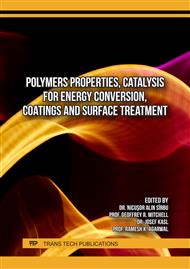[1]
Ursu, Daniel, et al, Enhanced Indoor Conversion Efficiency of Dye-Sensitized Solar Cells by Optimizing Ball-Milling Process of TiO2 Paste. Coatings 14 (2024) 283.
DOI: 10.3390/coatings14030283
Google Scholar
[2]
Aslam, Asad, et al, Dye-sensitized solar cells (DSSCs) as a potential photovoltaic technology for the self-powered internet of things (IoTs) applications. Solar Energy 207 (2020) 874-892.
DOI: 10.1016/j.solener.2020.07.029
Google Scholar
[3]
Lai, Fang-I., et al, Enhancing DSSC Performance through Manipulation of the Size of ZnO Nanorods. ACS omega 8 (2023) 40206-40211.
DOI: 10.1021/acsomega.3c03846
Google Scholar
[4]
Nakamoto, Trang, Kakeru Higuchi, and Kozo Taguchi, Effectiveness of Light Scattering Layer Using Mesoporous SiO2‐TiO2 Core‐Shell on Dye‐Sensitized Solar Cells. IEEJ Transactions on Electrical and Electronic Engineering 19 (2024) 157-159.
DOI: 10.1002/tee.23938
Google Scholar
[5]
Al-Alwani, Mahmoud AM, et al, Effect of solvents on the extraction of natural pigments and adsorption onto TiO2 for dye-sensitized solar cell applications. Spectrochimica Acta Part A: Molecular and Biomolecular Spectroscopy 138 (2015) 130-137.
DOI: 10.1016/j.saa.2014.11.018
Google Scholar
[6]
Wu, Kunjie, et al, Effect of ultra-thin ZnO coating layer on the device performance of TiO2 dye sensitized solar cell. Solar energy 94 (2013) 195-201.
DOI: 10.1016/j.solener.2013.05.008
Google Scholar
[7]
Xie, Yu-Long, et al, Growth of ZnO nanorods on TiO 2 nanoparticles films and their application to the electrode of dye-sensitized solar cells. Journal of Materials Science: Materials in Electronics 25 (2014) 2665-2670.
DOI: 10.1007/s10854-014-1926-y
Google Scholar
[8]
Minh, Luu Hoang, et al, Hollow ZnO nanorices prepared by a simple hydrothermal method for NO 2 and SO 2 gas sensors. RSC advances 11 (2021) 33613-33625.
DOI: 10.1039/d1ra05912b
Google Scholar
[9]
Nguyen, Dang-Trang, Ryota Fujimoto, and Kozo Taguchi, Waterproof India ink-coated activated carbon sheet counter electrode for quasi-solid DSSCs: Stability evaluation under indoor light conditions. Journal of Electronic Materials 51 (2022) 1548-1554.
DOI: 10.1007/s11664-021-09422-5
Google Scholar


